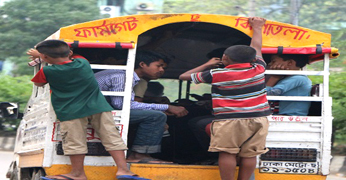By Emrana Ahmed
DHAKA, Nov 22, 2017 (BSS)- Hridoy, a 10-year-old boy, never went to school despite his intention to pursue study. A helper of Legoona tempo in Farmgate area, Hridoy doesn’t want to do risky odd job, rather he wants to study and play games and sports.
After the demise of his father, Hridoy and her mother had to hold the steering of their family. Alongside managing his family, he wants to pursue study to his two younger sisters.
The 12-year-old Anis is another tempo helper of the same area. After growing up, he wants to become a tempo driver. From Farmgate, over 200 tempoes move to different destinations of the capital and one can find the children working in almost all of the tempoes. As the wage of these children is very little than seniors, the tempo owners and drivers choose them as the helpers.
While visiting different bus and tempo stands of the capital, child labours were seen working with risk. The body and clothes of these children were turned into black colour for dust as they work almost throughout the day. They pick up passengers standing on the stands of the tempoes and collect fare from the passengers in the running vehicle.
The children often fall prey to accidents due to standing on the gates of the vehicles for hours after hours. Most of the children who survive the accidents become crippled forever.
Despite life risk, the child labours work in city transportation as the helpers for their survival. The age of these children is normally from 10 to 15. They are being deprived of education due to work for 14 hours from 8 am to 10 pm at a stretch. They get lunch break for one hour. But their everyday wages is only Taka 100 to Tk 200. They suffer from various complicated diseases like jaundice and kidney and asthmatic problems.
Ali Ahammad, a driver of Legoona tempo plying in Farmgate area, said a huge number of children are working in these vehicles risking their life. Only for poverty, the poor parents give their children to this odd job. While coming to work in the beginning, the children cry out of fear. Later they learn work gradually. Within four to five years, these children become complete drivers after taking training from the drivers.
Ahammad Ali said almost all of these tempo drivers hold fake (driving) licenses. It’s easy to collect fake licenses if money as bribe ranging from Taka 500-1000 is paid to some brokers.
Eminent economist and researcher Dr Abul Baraqat showed in a research that the economic plight is the main reason for engaging in work by the children. As many as 60 percent children are satisfied with getting work as the child labour as it’s a way of a poor family to counter poverty.
The research showed that 20 percent income of the families of child labours come from them, while 80 percent income of some families of the child labours come through the income of child labours.
Though the children do work for equal time of the seniors, they don’t get fair wages. The daily wage of those children who work over five hours in a day is below Taka 15 or equivalent to one meal and those who work eight hours is equipped to two meals.
These children are being deprived of education, as they work for a long time.. On an average, a child studied at school for four years and seven months and 59 percent children went to school for only two years and four months on an average.
Official sources said the total number of the children (5-18 years) in the country is four crore, 23 lakh and 90 thousands, and of them 32 lakh children are considered as child labours. The country’s children grow through various adversities including financial and natural calamities.
Though they are described as the main driving force of the future development, ensuring their rights and protection cannot be possible in the socioeconomic context. At the tender age, they are engaged in risky work.
Despite having all the potentialities, the natural blooming of their beautiful talents is being hampered seriously. Thousands of children are being deprived of education due to their engagement in child labour.
According to a research conducted by the International Labour Organization (ILO), 40 percent of the country’s total population are children and of them, 74 lakh are working children.
Chairman of Dhaka University Institute of Education and Research (IER) Professor Hosne Ara Begum said attention will have to be given to three issues to remove child labour.
Firstly, there is a need for economic stability for the poor families as they think whatever little be the children’s income it’s essential for running a family.
Stipend is being provided to the girl students at secondary level. Though this initiative has stopped the children to enter the labour market, the child labour cannot be removed completely by providing stipend only.
So the employers will have to ensure non-formal education for the children by keeping pace with their work.



